 Would you like a tour around the cultures of the world and discover the artistic and cultural heritage of diverse peoples from Africa, Asia, America and Oceania?
Would you like a tour around the cultures of the world and discover the artistic and cultural heritage of diverse peoples from Africa, Asia, America and Oceania?
To start the visit we suggest a tour via 12 outstanding works, a journey in time and space that will enable you to discover together as a family a large number of cultures through some of their most relevant artistic forms.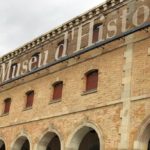 Located in the Palau de Mar, it is the sole building of Barcelona’s Old Port still standing. It was created in 1996 to promote the awareness and knowledge of the history and culture of Catalonia, both nationally and internationally. Its vocation as a national institution means that it aims to be a museum of society, encouraging the dialogue between history and the other social sciences, and with interest in contemporary events. Its cultural centre which is open and accessible to all, and its programmes offer users the chance to learn, debate and reflect as well as to enjoy their visit.
Located in the Palau de Mar, it is the sole building of Barcelona’s Old Port still standing. It was created in 1996 to promote the awareness and knowledge of the history and culture of Catalonia, both nationally and internationally. Its vocation as a national institution means that it aims to be a museum of society, encouraging the dialogue between history and the other social sciences, and with interest in contemporary events. Its cultural centre which is open and accessible to all, and its programmes offer users the chance to learn, debate and reflect as well as to enjoy their visit.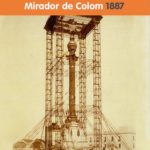 The monument is found at the end of Las Ramblas, Barcelona’s most famous avenue. You can go up to the top of the monument in a lift which allows you to take photos of beautiful views over the city. The idea to build the monument came from Antoni Fages i Ferrer in 1856. He proposed also that it should be constructed by Catalans only. It took him 16 years to convince the city’s mayor and finally in 1872 he won the mayor’s support. In 1881 a resolution was passed to build the monument. In a contest Spanish artists could submit their designs, but it was the Catalan artist Gaietà Buigas i Monravà who won. In 1882 the construction began and the monument was completed just in time for the 1888 Universal Exposition of Barcelona.
The monument is found at the end of Las Ramblas, Barcelona’s most famous avenue. You can go up to the top of the monument in a lift which allows you to take photos of beautiful views over the city. The idea to build the monument came from Antoni Fages i Ferrer in 1856. He proposed also that it should be constructed by Catalans only. It took him 16 years to convince the city’s mayor and finally in 1872 he won the mayor’s support. In 1881 a resolution was passed to build the monument. In a contest Spanish artists could submit their designs, but it was the Catalan artist Gaietà Buigas i Monravà who won. In 1882 the construction began and the monument was completed just in time for the 1888 Universal Exposition of Barcelona. Discover the city’s seafearing history from the medieval ages to the present day in the Drassanes Reials, formerly the royal shipyard. Since medieval times, the shipyard made vessels that conquered territories and traded with states across the Mediterranean. The shipyard was rebuilt in 1670, in the Catalan Gothic style of the original site. The museum displays exhibits inside the building and in the courtyard. Don’t miss the museum’s own ship, the Santa Eulàlia, an 1839 three-masted schooner once used for coastal trading.
Discover the city’s seafearing history from the medieval ages to the present day in the Drassanes Reials, formerly the royal shipyard. Since medieval times, the shipyard made vessels that conquered territories and traded with states across the Mediterranean. The shipyard was rebuilt in 1670, in the Catalan Gothic style of the original site. The museum displays exhibits inside the building and in the courtyard. Don’t miss the museum’s own ship, the Santa Eulàlia, an 1839 three-masted schooner once used for coastal trading.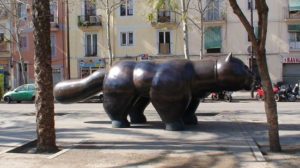 A true symbol of Barcelona and the Raval neighborhood. Botero’s sculpture is greeted with a smile by everyone and it has become an integral part of one of Barcelona’s most widely redeveloped areas and is a favorite meeting place. Some brave souls even clamber onto its back to have their photos taken. Botero’s monument is an element of vast proportions which is part of our everyday lives. The same style defines the Horse by the Colombian artist, which has stood in Terminal 2 of Barcelona Airport since 1992 and has become a meeting point for passengers.
A true symbol of Barcelona and the Raval neighborhood. Botero’s sculpture is greeted with a smile by everyone and it has become an integral part of one of Barcelona’s most widely redeveloped areas and is a favorite meeting place. Some brave souls even clamber onto its back to have their photos taken. Botero’s monument is an element of vast proportions which is part of our everyday lives. The same style defines the Horse by the Colombian artist, which has stood in Terminal 2 of Barcelona Airport since 1992 and has become a meeting point for passengers.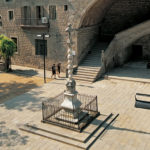 One of the finest examples of Catalan civil-Gothic architecture, these buildings were part of Barcelona’s main hospital until well into the 20th century. A look at the courtyards and high-ceilinged rooms which today house the Catalan library, art schools and other cultural organizations, will take you back to the atmosphere of a bygone age. Building work began in 1401, with the purpose of bringing together Barcelona’s six hospitals on one site. The building we see today is the result of refurbishments carried out a century later. In 1929, the hospital moved to a new modernista complex the Hospital de la Santa Creu i de Sant Pau. The old hospital, which had become obsolete, was declared a Historic and Artistic Landmark of National Interest.
One of the finest examples of Catalan civil-Gothic architecture, these buildings were part of Barcelona’s main hospital until well into the 20th century. A look at the courtyards and high-ceilinged rooms which today house the Catalan library, art schools and other cultural organizations, will take you back to the atmosphere of a bygone age. Building work began in 1401, with the purpose of bringing together Barcelona’s six hospitals on one site. The building we see today is the result of refurbishments carried out a century later. In 1929, the hospital moved to a new modernista complex the Hospital de la Santa Creu i de Sant Pau. The old hospital, which had become obsolete, was declared a Historic and Artistic Landmark of National Interest. Thousands of people walk over this pavement mosaic in the centre of Barcelona’s Rambla. It goes unnoticed by some, others stop to look at the characteristic colors used by the Barcelona-born artist. However, few people know that an important Rambla landmark once stood opposite this site: the famous Boqueria gate.
Thousands of people walk over this pavement mosaic in the centre of Barcelona’s Rambla. It goes unnoticed by some, others stop to look at the characteristic colors used by the Barcelona-born artist. However, few people know that an important Rambla landmark once stood opposite this site: the famous Boqueria gate.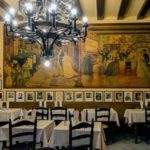 Following the advice written on the door “Pull the door to open”, guests enter a spacious interior that evokes the Modernist period, with huge paintings in the lounges depicting bygone life. Signature menus include the 1786 Special Menu and the Agut-Manubens Family Menu, which feature the most celebrated dishes that have brought fame to the restaurant.“Noies, culleretes!” / “Girls, teaspoons!” was a common phrase used daily by the head waiter to prompt the girls to polish the teaspoons. His dedication to serve his guests with care and respect was second to none, and named the oldest restaurant of Barcelona.
Following the advice written on the door “Pull the door to open”, guests enter a spacious interior that evokes the Modernist period, with huge paintings in the lounges depicting bygone life. Signature menus include the 1786 Special Menu and the Agut-Manubens Family Menu, which feature the most celebrated dishes that have brought fame to the restaurant.“Noies, culleretes!” / “Girls, teaspoons!” was a common phrase used daily by the head waiter to prompt the girls to polish the teaspoons. His dedication to serve his guests with care and respect was second to none, and named the oldest restaurant of Barcelona.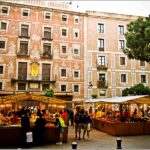 On entering this square, look for the spectacular window displays of fierce implements at the knife shop Ganiveteria Roca. The area is dominated by the fortresslike facade of Santa María del Pi. Built between 1319-1391, the church is pure Catalan Gothic. The beautiful multicolored rose window was restored by Jujol, one of Gaudi’s close associates, after being damaged in the Spanish Civil War. Frequent arts and crafts fairs, as well as sales of natural foods such as honey and “mató” (a mild cheese) are held in this square.
On entering this square, look for the spectacular window displays of fierce implements at the knife shop Ganiveteria Roca. The area is dominated by the fortresslike facade of Santa María del Pi. Built between 1319-1391, the church is pure Catalan Gothic. The beautiful multicolored rose window was restored by Jujol, one of Gaudi’s close associates, after being damaged in the Spanish Civil War. Frequent arts and crafts fairs, as well as sales of natural foods such as honey and “mató” (a mild cheese) are held in this square.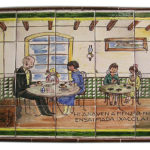 In the heart of Barcelona, just a short walk from La Rambla, is one of the most historical narrow streets in the city, the hot chocolate carrer! With a width of just 3m and a length of 129m, stretching from Plaça Del Pi to carrer Portaferrissa, it is full of interesting shops and art galleries, many with a rich history.Of particular interest are the famous ‘granjas’, the cafes that serve the best hot chocolate in Barcelona!
In the heart of Barcelona, just a short walk from La Rambla, is one of the most historical narrow streets in the city, the hot chocolate carrer! With a width of just 3m and a length of 129m, stretching from Plaça Del Pi to carrer Portaferrissa, it is full of interesting shops and art galleries, many with a rich history.Of particular interest are the famous ‘granjas’, the cafes that serve the best hot chocolate in Barcelona!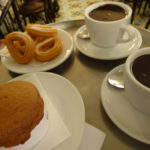 One of the oldest coffee places in Barcelona that opened back in 1870. It seems as if time has stood still for more than a century. The place has preserved the charming decoration of past times. Hidden just off the Ramblas, in the lively quarter of Raval, locals come to enjoy delicious hot chocolate and pastries. Its menu is perhaps best known for its homemade mató (fresh cheese), its Swiss chocolate, lady fingers, and traditional Mallorcan pastries, thought by many to be the best in Barcelona. You’ll also find sobrasada, foie-gras sandwiches, cheesecake, pies, and gluten-free delights. Not only is the café known for its hot chocolate and pastries but for inventing Cacaolat in 1931, the most famous chocolate milkshake brand in Spain. Look around and you will see on the walls the whole history of this old café and family. If you don’t fancy anything sweet, have a look at the large selection of cold meat they have at the entrance.
One of the oldest coffee places in Barcelona that opened back in 1870. It seems as if time has stood still for more than a century. The place has preserved the charming decoration of past times. Hidden just off the Ramblas, in the lively quarter of Raval, locals come to enjoy delicious hot chocolate and pastries. Its menu is perhaps best known for its homemade mató (fresh cheese), its Swiss chocolate, lady fingers, and traditional Mallorcan pastries, thought by many to be the best in Barcelona. You’ll also find sobrasada, foie-gras sandwiches, cheesecake, pies, and gluten-free delights. Not only is the café known for its hot chocolate and pastries but for inventing Cacaolat in 1931, the most famous chocolate milkshake brand in Spain. Look around and you will see on the walls the whole history of this old café and family. If you don’t fancy anything sweet, have a look at the large selection of cold meat they have at the entrance. Have you ever wondered what Barcelona tastes like?
Have you ever wondered what Barcelona tastes like?
The authentic taste of Barcelona lies in its history, and this market, one of the first built in the city, still preserves and shows it through the expertise of the people who have made it their home. All the traditions of fishermen, artisans and winegrowers have been passed down from one generation to the next, filling this amazing space with stories, curiosities and of course, the choicest products.“a gastronomic temple”
Ferran Adrià
Chef at El Bulli Restaurant“comprises not only the market itself, but an entire human itinerary in which traders and shoppers pose for onlookers to see them at their best, taking part in an astounding performance by buyers and sellers.”
Manuel Vázquez Montalban
Writer
ADDRESSES
- Museum of World Cultures of Barcelona ( Museu de Cultures del Món )
- Museum of the History of Catalonia ( Museu d’Història de Catalunya )
- Christopher Columbus Monument ( Mirador de Colom )
- Maritime Museum of Barcelona ( MUSEU MARÍTIM DE BARCELONA )
- Cat, Fernando Botero ( El Gato de Botero )
- The Antic Hospital de la Santa Creu
- Joan Miró’s Mosaic
- Restaurant Can Culleretes
- Plaça del Pi
- Carrer Petritxol
- Granja Viader
- Mercat de Sant Josep de la Boqueria
Carrer Montcada, 12
Plaça de Pau Vila, 3
Plaça del Portal de la Pau
Av. de les Drassanes
Rambla del Raval
Carrer de l’Hospital, 56
Pla de l’Os, La Rambla, 71
C/ Quintana, 5
Carrer d’en Xuclà, 4-6
La Rambla, 91
MAP
